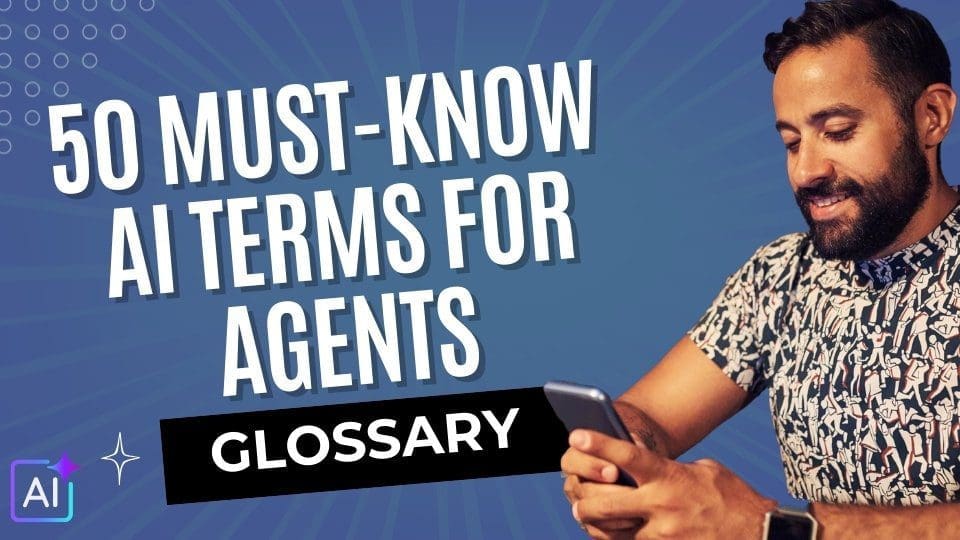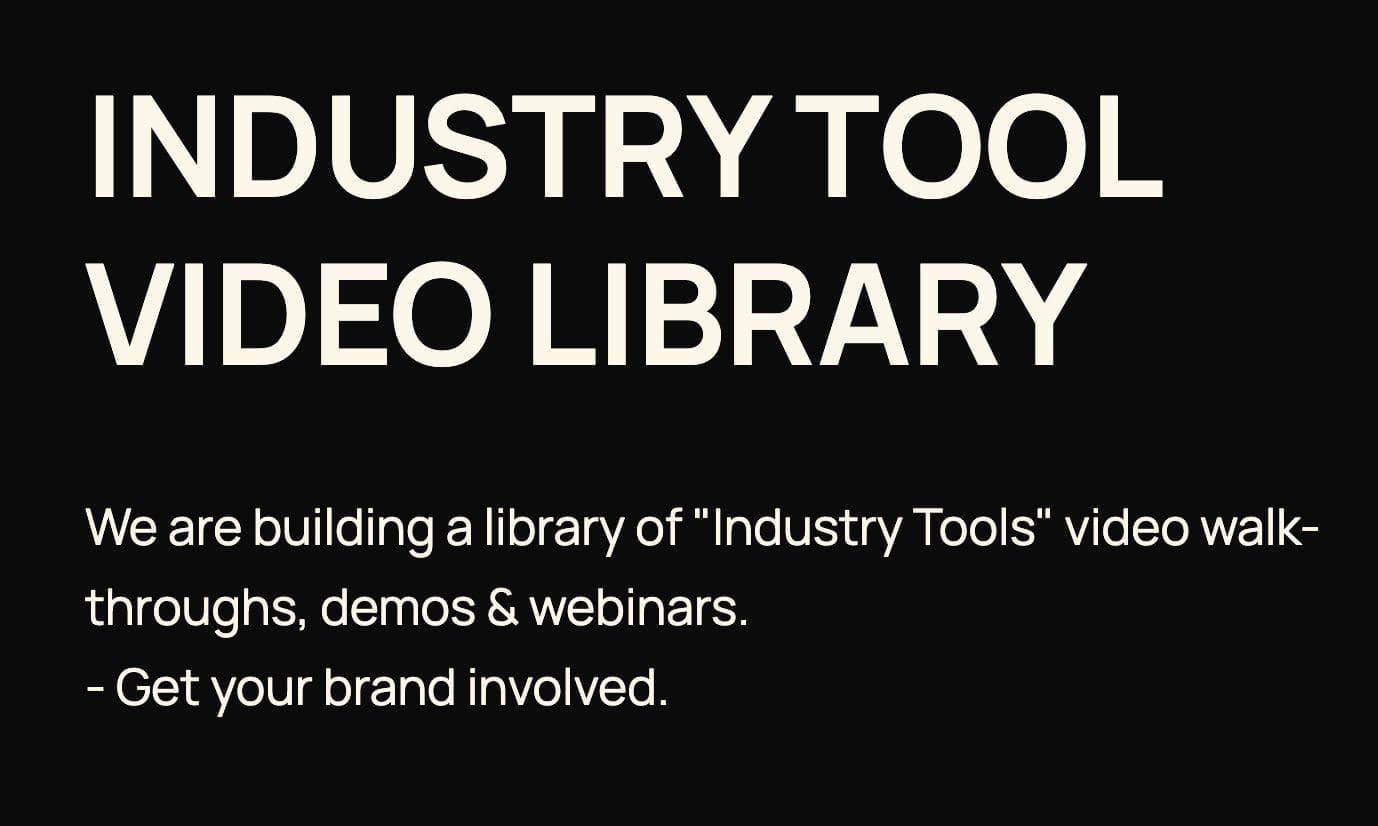AI Learning Centres:
- AI – Learn The Basics
- Get The Most From ChatGPT
- Branding in The Age of AI
- AI for Client Experience
- AI For Prospecting
- AI For Marketing
- AI For Listings & Ads
- Team Adoption of AI
- AI For PM
- AIO & Generative Search
- AI For Operations & Efficiency
- AI For Market Research & Analysis
- AI Ethics, Privacy & Compliance in Real Estate
Digital Marketing & Social Media Learning Centres:
Guides & Downloads

Glossary of 50 Must-Know AI Terms for Agents
Glossary: 50 Must-Know AI Terms
Use this quick-reference list whenever tech talk pops up in your day. Each term is explained in plain language and linked to how it can help a real-estate agent’s work.
Artificial Intelligence (AI) – Computer systems that can do tasks that normally need human thinking, like matching buyers to homes or writing listing copy.
Algorithm – A step-by-step recipe a computer follows to solve a problem, such as ranking leads by urgency.
Machine Learning (ML) – A branch of AI where the program learns from data instead of being hand-coded for every rule, improving the accuracy of price estimates over time.
Deep Learning – An advanced ML method that stacks many “layers” (like Lego blocks) to spot complex patterns, for example recognising kitchen photos in a property album.
Neural Network – The model inside deep learning, inspired by the brain, that turns raw data into predictions (e.g., likely sale price).
Large Language Model (LLM) – A very big neural network trained on billions of words, able to draft emails, ads, and reports in seconds.
Natural Language Processing (NLP) – Techniques that let computers read, understand, and write human language, making chatbots sound conversational.
Prompt – The instructions you type to tell an AI what you want, such as “Write an open-home reminder in a friendly tone.”
Training Data – The examples an AI studies to learn, like past sales records, suburb profiles, or past email campaigns.
Dataset – An organised bundle of training data kept in one place.
Supervised Learning – Training where each example has a correct answer, teaching the model, for instance, which listings actually sold.
Unsupervised Learning – Training without labelled answers, letting the AI group similar buyers or neighbourhoods on its own.
Reinforcement Learning – Learning by trial and error with rewards, useful for chatbots that improve responses over many conversations.
Model – The finished AI program that makes predictions, like suggesting ideal asking prices.
Fine-Tuning – Teaching an existing model on your agency’s specific data so its answers sound on-brand.
Token – A tiny chunk of text the model processes; tokens set how long prompts and outputs can be.
Embedding – Turning text into numerical fingerprints so the AI can quickly search and match, useful for finding similar buyer enquiries.
Vector Database – A storage system built to hold embeddings, speeding up tasks like “show me similar listings.”
API (Application Programming Interface) – A door that lets two apps talk; for instance, connecting your CRM to an AI summariser.
Chatbot – A conversational tool powered by NLP that answers questions from leads 24/7.
Generative AI – AI that creates something new—text, images, or video—like a draft suburb-profile video.
Bias – Unfair skew in data or results that can favour or exclude certain groups; needs checking so marketing stays compliant.
Overfitting – When a model memorises the training data and performs poorly on new situations, like mis-pricing a home outside its usual area.
Underfitting – When a model is too simple and misses important patterns, leading to vague predictions.
Computer Vision – AI that “sees” images, handy for sorting property photos by room type automatically.
Speech Recognition – Converting spoken words to text—great for turning voice notes into CRM entries.
Sentiment Analysis – Detecting positive or negative tone in reviews or social comments to spot happy or unhappy clients.
Automation – Letting software handle repetitive tasks, freeing you to focus on relationships.
Predictive Analytics – Using past data to forecast future events, such as likelihood a lead will list in 90 days.
Data Privacy – Protecting personal information and following laws like the Privacy Act 1988.
Data Anonymisation – Removing identifying details so data can be used safely for AI training.
Model Drift – When a model’s accuracy drops as market conditions change; it signals a need for retraining.
Edge Computing – Running AI on local devices (like a phone) instead of the cloud, cutting delays during on-site inspections.
Cloud Computing – Renting powerful remote servers to run AI without buying hardware.
API Key – A secret code that unlocks an AI service for your software—treat it like a password.
Confidence Score – A number (often 0–1) showing how sure the AI is about its answer; low scores mean you should double-check.
Inference – The moment a trained model makes a prediction, e.g., suggesting the best buyer for a new listing.
Prompt Engineering – Crafting prompts carefully to steer the AI toward useful, accurate output.
Zero-Shot Learning – The model tackles a task it never saw during training, like writing a new style of letter on the first try.
Few-Shot Learning – Showing the model a handful of examples so it mimics your preferred tone.
Transfer Learning – Re-using knowledge from one task for another, cutting training time.
Epoch – One full pass through the training data during model training.
Latency – The delay between asking the AI and getting an answer; lower latency keeps conversations smooth.
Token Limit – The maximum number of tokens a model can handle in one go; long messages may need trimming.
Hallucination – When an AI confidently invents facts—always verify critical details like contract terms.
Explainable AI (XAI) – Tools that show why the model gave a result, building trust with clients.
Robotic Process Automation (RPA) – Software bots that click and type like a human, great for moving data between old systems.
Synthetic Data – Computer-generated data that mimics real patterns without exposing actual clients.
Model Accuracy – How often a model’s predictions are correct; tracked to keep performance high.
Knowledge Graph – A map of people, places, and things the AI uses to answer complex questions, like “Which schools are near this listing?”.
Keep this glossary handy—understanding these 50 terms turns tech jargon into everyday conversation and helps you spot new ways AI can lighten your workload, sharpen your marketing, and win more deals.
Author – Ken Hobson.






